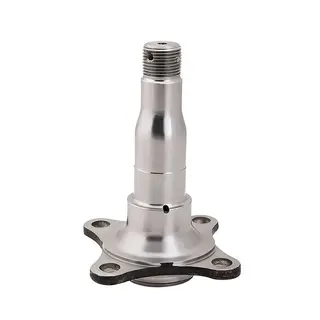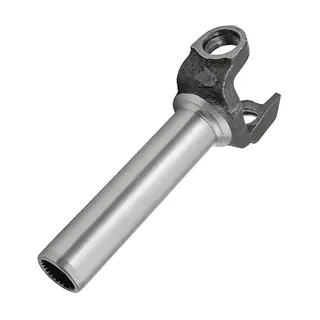In the field of metalworking, forgings are indispensable components in many mechanical devices. Their quality and performance directly affect the overall reliability and safety of the product. However, during the forging process, for various reasons, cracks may appear in forgings. This not only affects their appearance but, more importantly, reduces their mechanical properties and service life. Therefore, understanding how to treat and prevent forging cracks is crucial.
In actual production, there are various types of forging cracks, commonly including transverse cracks, longitudinal cracks, high-temperature forging cracks, and low-temperature forging cracks. Understanding these types and their causes helps in adopting targeted preventive measures.
Transverse cracks on forgings are divided into surface transverse cracks and internal transverse cracks. The formation of surface transverse cracks is mainly due to several reasons: shallow cracks are caused by unbonded sub-surface gas bubbles in the steel ingot; deeper cracks result from factors during ingot casting such as the quality of the mold wall, steel flow, and bonding between the ingot and mold. The generation of internal transverse cracks is mainly caused by cold ingots being heated too quickly in low-temperature zones during forging, resulting in large tensile stress in the center, or due to the poor plasticity of high-carbon steel and high-alloy steel when the forging feed is relatively small.
Longitudinal cracks on forgings are also divided into surface longitudinal cracks and internal longitudinal cracks. The causes of surface longitudinal cracks are more complex: some occur during the first elongation or upsetting, and some appear near the cap center of the billet. The former is caused by defects in the mold wall, inadequate annealing of a new mold, improper operation, or improper cooling when the ingot is demolded after high-temperature, high-speed casting, excessive compression during chamfering, or longitudinal scratches generated during rolling of the ingot. The latter is mainly due to shrinkage cavities not being concentrated in the cap during cooling, insufficient trimming of the billet cap end, leaving secondary shrinkage or residual shrinkage near the billet cap end. Internal longitudinal cracks mainly occur due to tensile stress in the metal center. In addition, incomplete heating of the billet or low internal temperature can also cause cracks along the longitudinal direction during elongation.
Cracks may also be caused by improper forging deformation temperatures. High-temperature and low-temperature forging cracks appear on forgings as surface cracks, internal cracks, and burr cracks. Surface cracks are caused by excessive forging temperature or hammering speed, leading to overheating or overburning of the billet. The crack openings are relatively wide, fracture surfaces are uneven, the microstructure is coarse and dark gray, and at low magnification, the crack ends are saw-toothed and unrelated to flow lines. At high magnification, cracks extend along grain boundaries, with complete recrystallization and no inclusions or other metallurgical defects. Low-temperature forging cracks occur due to excessively low forging temperature and heavy hammering, forming 45°, 90°, or triangular cracks on the side surface of the billet in the hammering direction. Fracture surfaces are smooth with metallic luster. At high magnification, cracks penetrate grains with work hardening phenomena.
When cracks appear on forgings, it is necessary to formulate specific treatment plans according to the type, location, and severity of the cracks. Common treatment methods include:
For minor cracks appearing at small fillets, side plates can be added and welding repair can be applied. Before welding, the cracked area must be cleaned and free of impurities to improve welding quality. After welding, handheld grinders should be used to polish the welded area to restore the surface flatness of the forging. This method is suitable for cracks that are shallow and do not affect the overall structure of the forging.
If the forging mold cavity has severe defects, such as collapse or deformation, accompanied by cracks, build-up welding can be used for repair. Before welding, the area to be repaired must be cleaned, and a V groove should be prepared according to the crack situation to facilitate better weld filling. After build-up welding, the repaired area should be ground to restore its original shape and dimensions. Build-up welding is a relatively complex repair method, requiring skilled technicians and equipment.
For small local damage on forgings, such as burrs, micro-cracks, or minor wear, tools such as pneumatic grinders, chisels, and flat files can be used for manual repair. In addition, electro-brush plating technology can be used to repair and strengthen the mold surface. Electro-brush plating is simple to operate, fast, and cost-effective, and is especially suitable for repairing surface scratches, roughness, and corrosion wear on molds. After repair, the mold's wear resistance, hardness, and surface roughness meet the required performance standards.
Treating forging cracks is only a temporary solution; it is more important to prevent cracks from occurring at the source. During forging, cracks are often related to multiple factors including forging processes, raw material quality, and mold design. Therefore, preventing cracks requires action on multiple fronts.
Selecting high-quality raw materials is the foundation for preventing cracks. Inclusions, pores, and other defects in raw materials significantly affect the mechanical properties and crack resistance of forgings. Therefore, during material selection, strict quality control should be implemented to ensure compliance with relevant standards. Micro-cracks and structural defects in raw materials should be thoroughly removed before forging.
Optimizing the forging process is key to preventing cracks. During forging, parameters such as temperature, deformation speed, and deformation degree should be properly controlled to avoid cracks caused by excessive or insufficient heat, too fast deformation, or excessive deformation. In addition, the appropriate mold and forging method should be selected according to the shape and size of the forging to reduce friction and extrusion by the mold, thereby reducing the risk of cracks.
Mold design is also an important factor in preventing cracks. The mold should fully consider the shape, size, and deformation characteristics of the forging to ensure that the mold cavity matches the forging shape, reducing mold extrusion and friction. Mold materials and heat treatment should meet requirements to enhance mold strength and wear resistance, reducing cracks caused by mold wear during use.
Strengthening quality control and monitoring during the forging process is also an important means of preventing cracks. Regular inspection and maintenance of forging equipment, molds, and raw materials should be conducted to ensure proper working conditions. In addition, process monitoring and control should be strengthened to detect and address abnormalities promptly, preventing cracks caused by equipment failure or operational errors.
After discussing the treatment methods and causes of forging cracks, we naturally consider how to prevent these issues from the source. The following measures help reduce or even eliminate the occurrence of cracks during forging, ensuring the quality and performance of forgings.
Material quality is fundamental to preventing cracks. High-quality raw materials that meet standards should be selected, and strict inspections conducted. Micro-cracks and structural defects should be removed before forging. Non-destructive testing such as ultrasonic inspection and magnetic particle inspection can be employed to ensure material quality.
Optimizing the forging process is key. During forging, temperature, deformation speed, and deformation degree should be properly controlled. For high-carbon and high-alloy steels, the forging temperature should be slightly reduced to avoid overheating. Suitable molds and forging methods should be selected to reduce mold friction and extrusion. For example, during elongation of round billets, first form a square, then an octagon, then roll to round, with each compression exceeding 20%, effectively reducing internal longitudinal cracks.
Mold design is also critical in preventing cracks. Fillet radii can be increased at crack-prone areas to reduce stress concentration. High-strength, high-toughness mold steel with proper heat treatment should be used to improve mold strength and wear resistance, reducing cracks from mold wear during use.
During forging, sensors and monitoring devices can be installed to track temperature, pressure, and other parameters in real time, with immediate corrective action for anomalies. Regular sampling and full inspection ensure forging quality compliance.
To illustrate the treatment and prevention of forging cracks, consider a mechanical manufacturing company producing a batch of high-carbon steel forgings. During forging, transverse cracks appeared on some forgings. Analysis revealed that these cracks were mainly due to micro-cracks in the raw materials not being fully removed and improper temperature control during forging. The company implemented the following measures:
Strict control of raw materials: Ultrasonic testing was performed to ensure no micro-cracks or defects, and pre-treatment such as annealing improved material plasticity and toughness.
Optimization of forging process: Forging temperature was controlled according to the characteristics of high-carbon steel to avoid overheating, and suitable molds and forging methods were selected to reduce friction and extrusion.
Optimization of mold design: Mold fillet radii were increased, high-strength, tough mold steel was used, and proper heat treatment was applied to improve strength and wear resistance.
Strengthening quality control and monitoring: Sensors and monitoring devices tracked temperature, pressure, and other parameters in real time. Routine inspections and sampling ensured forging quality.
These measures successfully resolved the transverse cracks, improving forging quality and performance, and ensuring product reliability and safety.
The treatment and prevention of forging cracks is an important topic in metalworking. Through proper treatment methods and effective preventive measures, the occurrence of forging cracks can be significantly reduced, improving forging quality and performance, and ensuring product reliability and safety. In actual production, multiple methods and measures should be comprehensively applied, including strict raw material control, optimization of forging processes, mold design improvements, and strengthened quality control and monitoring, to fully enhance forging quality and performance. Only in this way can enterprises remain competitive and provide high-quality products and services to customers.



